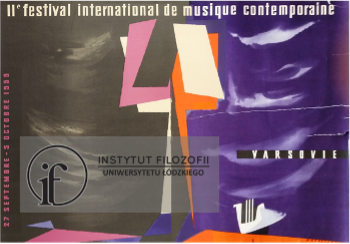
written by Jakub Kokoszka (25.04.2019)
updated by Editors (19.06.2020)
translated by Editors (10.11.2020)
The Warsaw Autumn is an annual (excluding two years) , initiated by two composers, Tadeusz Baird and Kazimierz Serocki, in 1956, and since then held by the The Association of Polish Composers.
One of the ideas which drove the festival’s initiators was to distance themselves from the so-called “creative method”, which was one of the assumptions of socialist realism. However, the communist authorities had different goals in mind for this undertaking – they perceived the festival as a test of political and cultural tug of war. In 1954 Bolesław Bierut said in an interview, “It is interesting, such a comparison between the East and the West. They will show what they have, and we will show what we have”1.
The goals of the festival were set out in six points: 1. we ought to promote Polish music; 2. we need to get acquainted with the music of foreign countries; 3. we need to present performances of the best symphony orchestras and chamber ensembles; 4. we have to treat this festival as a resource of object lessons for Polish composers and members of symphony orchestras and chamber ensembles; 5. we have to establish contacts between Polish and foreign composers (to exchange opinions on composing contemporary music); 6. we ought to establish Warsaw as a cultural music centre known all over the world2.
This somewhat strange list – combined with the obligation of foreign orchestras and ensembles to perform at least one Polish piece (minimum 30 minutes long), and with defining “contemporary music” as covering the entire 20th century (despite Tadeusz Baird’s opposition, who called for presenting only works written within the previous year3) – presents a picture of a clash between “politically incorrect” initiative (which could not be fully implemented at that time) with a politically con¬trolled culture.
This opposition to the ideologization of art, which was Baird and Serocki’s hidden assumption, is visible in the poster by Adam Młodzianowski promoting the second edition of the festival (1958). This artist, a graduate of the State Institute of Fine Arts in Cracow, dealt with book graphics and woodcut, and also became famous for arranging museum interiors, e.g. at the Wawel Royal Castle[4]. The composition is highly geometrical, almost abstract, divided into two parts. This is probably how it refers to the West-East opposition, appropriately presented on the poster as a juxtaposition of a “colourless” and coloured backgrounds, and highlighted with the motif of a dove-styled instrument (representing peace) on the eastern part. Both “worlds” are separated by a sheet music stand. In fact, this ideological idealization, which was obligatory at that time, is almost imperceptible. It has been satisfactorily neutralized with pure artistic media. This ability to escape censorship is considered one of the most important features of the Polish School of Poster Art.
1 Małgorzata Gąsiorowska, “The Warsaw Autumn International Festival of Contemporary Music. Transformations of Programming Policies”, Musicology Today 2017, Vol. 14, p. 24. Bierut was then the prime minister and the president (there is a factual error in this article).
2 Ibid., 25.
3 Ibid., 29.
